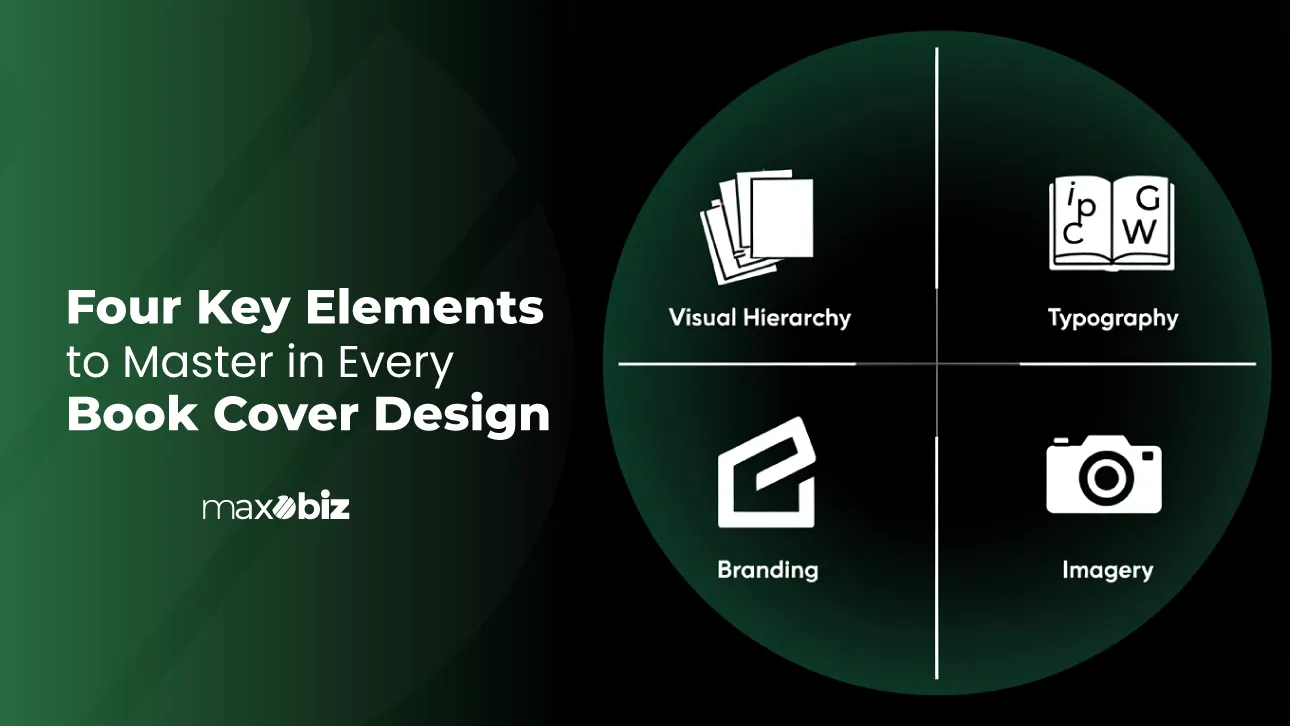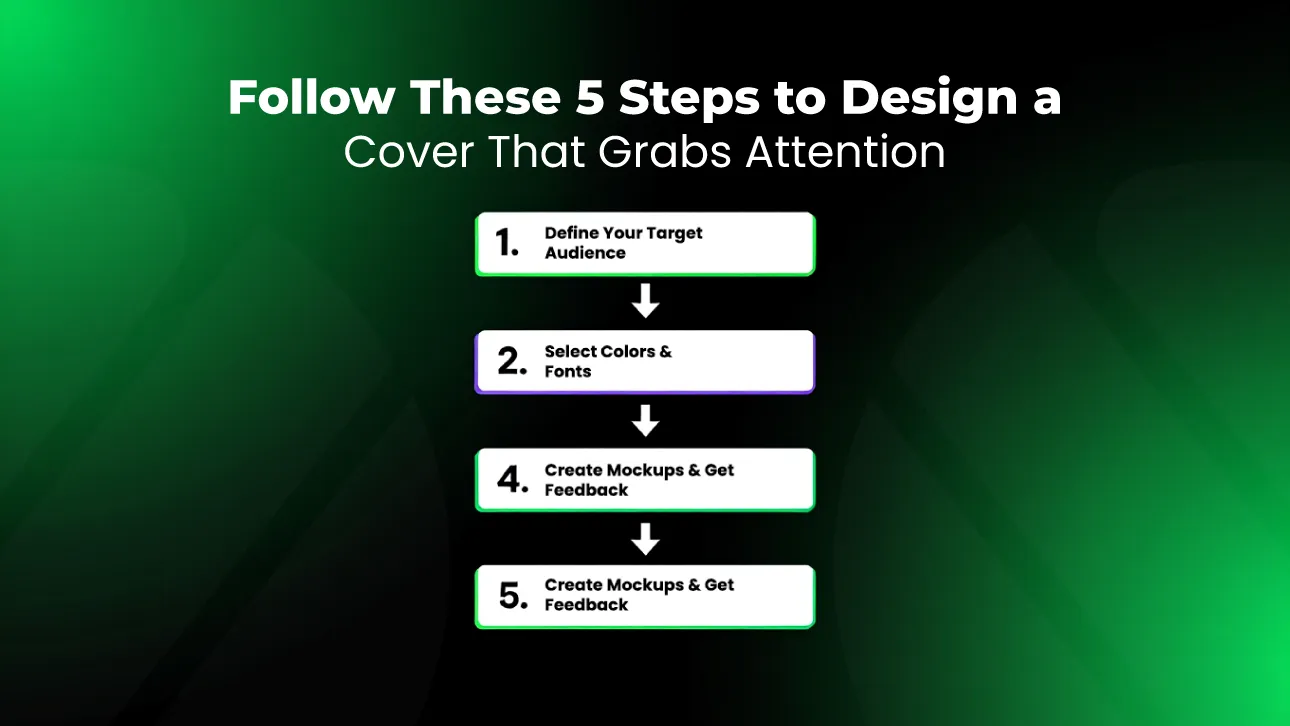A book’s cover is the readers’ first interaction with its content. 70% of people make the decision whether to buy the book or not based on its cover. The trends in book cover design are evolving fast in 2025, that is why, authors and publishers need to design attractive and professional designs.
This blog post will guide you through a step-by-step process of designing the cover. We will discuss common mistakes, emerging trends, and the importance of book covers. If you’re looking to enhance your visuals, you can also explore our professional book cover design services for tailored support. This blog post will be useful for you whether you are a seasonal professional or new to writing and publishing.
Why Does Book Front Cover Matter?

A compelling book cover not only grabs attention but also delivers essential cues about the content inside. It sets the stage for the reader by hinting at the genre, tone, and style of the book—ultimately increasing engagement and driving interest.
First Impression Drives Sales
A professionally designed cover instantly creates a sense of credibility. Readers are more likely to believe that the content is worth their time and money, which boosts sales potential right from the shelf or screen.
Establishing Genre and Theme
Your book cover should clearly reflect its genre and core theme. For example, romance novels often feature soft colors and emotional imagery, while sci-fi thrillers may showcase futuristic or dark visuals—helping readers know what to expect before they even open the book.
Marketing Tool
Your book cover acts as a powerful marketing tool, whether displayed in a bookstore or listed online. A strong design compels potential readers to pick it up or click through—driving conversions naturally.
To make a great first impression, authors and designers must combine artistic creativity with smart marketing tactics when crafting the book cover.
Key Elements of a Great Book Front Cover

Do you want to master the art of book cover design? Then it’s essential to understand and apply the key elements that make a front cover stand out. Here are the core components every designer should consider:
Visual Hierarchy
A well-structured layout guides the reader’s eye naturally—from the title to the subtitle, and then to the author’s name. Maintain balanced spacing and harmonious color usage to keep the design clean and professional.
Typography
Choose fonts that align with your book’s genre. Serif fonts work well for historical or nonfiction titles, while bold sans-serif fonts are ideal for modern thrillers. Avoid overly complex fonts that may hinder readability. The fonts should align with the book’s genre. For more guidance, check out these font selection tips to ensure the typography fits your theme.
Imagery and Graphics
High-quality illustrations significantly boost a book’s appeal. Avoid generic stock photos—instead, invest in custom artwork or licensed imagery. A unique visual identity enhances perceived value and reader engagement.
Branding
Branding incorporates your brand identity elements—such as your logo, signature colors, or visual motifs—into the book cover. This strengthens brand recognition and creates a cohesive look across your publications.
Step-by-Step Guide: How to Design a Book Cover

What goes into professional book cover design? It’s a common question for many aspiring authors and designers. Here’s a practical, step-by-step guide to help you craft a compelling cover that captures attention and resonates with your readers:
Step 1: Define Your Target Audience
Begin by identifying your audience. Are you targeting young adults, mystery lovers, or fantasy enthusiasts? Research popular covers in your genre to understand visual trends that align with your book’s message.
Step 2: Choose the Right Cover Design Tools
Select a design platform such as Canva, Adobe InDesign, or Book Brush. These tools offer ready-to-use templates and professional features that help streamline your design process.
Step 3: Select Colors and Fonts Wisely
Colors set the emotional tone. Use pastels for romance novels and darker shades for horror. Choose fonts that align with the theme—serif fonts for historical fiction, sans-serif for modern thrillers. Ensure readability at all sizes.
Step 4: Create a Mockup and Refine
Design multiple mockups and get feedback from peers, colleagues, or friends. Fresh perspectives can highlight areas for improvement and help you polish the final design.
Step 5: Ensure Print-Ready Files
Finalize your cover in the proper format. Use 300 DPI resolution and export in standard formats like PDF or TIFF. This ensures your cover prints clearly and professionally.
By following these steps, you can master the art of book cover design and create covers that truly stand out in a competitive marketplace.
Trends in Book Front Cover Design for 2025

Stay ahead of the curve by incorporating the latest 2025 book cover design trends. These evolving styles not only attract modern readers but also ensure your book appears fresh and relevant in a fast-paced publishing world:
Minimalist Designs
Clean, uncluttered covers with bold titles and simple visuals are dominating the industry. These designs focus on clarity and elegance, making it easier for readers to quickly grasp the essence of the book.
Bold Typography
Large, impactful fonts are trending—particularly in genres like contemporary fiction and self-help. These striking typographic treatments ensure titles stand out both on shelves and digital platforms.
Textured Effects
Designers are using tactile finishes such as embossing, foil stamping, and textured backgrounds to add a luxurious feel to printed covers. These elements elevate the perceived value of the book.
Eco-Friendly Materials
Sustainability is top of mind for authors and publishers. Many are now choosing recyclable and biodegradable materials for physical book covers to reduce their environmental impact.
Digital-First Designs
With the rise of eBooks, vibrant colors and mobile-optimized cover layouts are key. These digital-friendly designs help attract readers browsing online bookstores or scrolling through preview libraries.
By aligning your book design with these 2025 trends, you enhance its market appeal and ensure it remains visually competitive in today’s dynamic publishing landscape.
Mistakes to Avoid in Book Front Cover Design

To maintain a professional appearance and ensure your cover communicates effectively, steer clear of these common book front cover design mistakes:
Using Low-Quality Images
Avoid blurry or pixelated images, as they significantly diminish the perceived quality of your book. A sharp, high-resolution image enhances credibility and visual appeal.
Overcrowding the Design
Overloading your cover with too many elements—text, images, or patterns—can confuse potential readers. A clean, uncluttered design makes the book easier to scan and encourages quicker purchase decisions.
Unreadable Fonts
Fancy or overly stylized fonts might look creative but often compromise readability—especially on smaller screens. Always prioritize clarity and legibility in your typography choices.
By avoiding these design missteps, you enhance the professionalism and impact of your book’s cover, making it more appealing to your target audience.
Conclusion
In conclusion, a well-designed book cover is more than just a pretty face. It is a strategic tool to grab attention, convey the book’s essence, and drive sales. You can stand out your book in the competitive market by understanding the complete guide on book front cover design.
For authors seeking professional, eye-catching designs, Maxobiz offers top-tier book cover design services tailored to your genre and brand—ensuring your book stands out in any market.
Remember, thoughtful design has the power to captivate readers and make your book unforgettable. So, whether you design it yourself or hire a professional, invest time and effort into creating a cover that truly represents your work.























